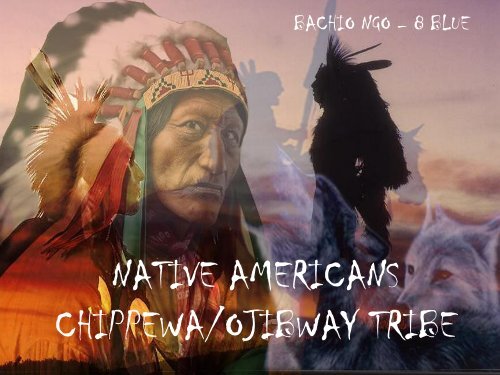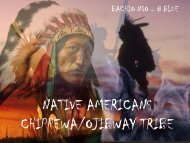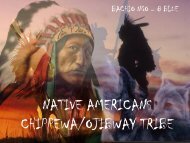Create successful ePaper yourself
Turn your PDF publications into a flip-book with our unique Google optimized e-Paper software.
BACHIO NGO – 8 BLUE<br />
<strong>NATIVE</strong> <strong>AMERICANS</strong><br />
CHIPPEWA/OJIBWAY TRIBE
DIFFERENCE BETWEEN CHIPPEWA<br />
AND OJIBWAY TRIBE<br />
There is no difference. All these<br />
different spellings refer to the same people. In<br />
the United States more people use 'Chippewa,'<br />
and in Canada more people use 'Ojibway,' but all<br />
two of these spellings are common. The Ojibway<br />
people call themselves Anishinabe in their own<br />
language, which means 'original person.'
WHERE DID THE<br />
CHIPPEWA TRIBE LIVE<br />
The Chippewa’s are one of the largest American<br />
Indian groups in North America. There are<br />
nearly 150 different bands of Chippewa Indians<br />
living throughout their original home land in the<br />
northern United States<br />
(especially Minnesota, Wisconsin and Michigan)<br />
and southern Canada (especially Ontario,<br />
Manitoba and Saskatchewan).
RED DOT = A BAND
WHAT KIND OF HOUSES DO<br />
THE CHIPPEWA TRIBE LIVE IN?<br />
The Chippewa’s live in two types of dwellings. In<br />
the woodlands, the Chippewa people lived in<br />
villages of birch bark houses called waginogans, or<br />
wigwams. On the Great Plains, the Chippewa’s<br />
lived in large buffalo-hide tents called tipis. The<br />
Chippewa’s that lived in the Great Plains were<br />
nomadic people, and tepees were easier to move<br />
from place to place than a waginogan.
TEPEES
BIRCH BARK HOUSE
HOW THE<br />
CHIPPEWA PEOPLE LIVE<br />
Chippewa women were farmers and did most of<br />
the child care and cooking. Men were hunters<br />
and sometimes went to war to protect their<br />
families. But adult in the tribe tells stories,<br />
artwork and music, and traditional medicine.<br />
Chippewa men and women worked together to<br />
harvest wild rice. A Chippewa man used a pole<br />
to steer through the reeds, while his wife<br />
knocked rice grains into the canoe.
CLOTHES THE<br />
CHIPPEWA PEOPLE WORE<br />
Chippewa women wore long dresses with<br />
removable sleeves. Chippewa men<br />
wore breechcloths and leggings. Everybody<br />
wore moccasins on their feet and cloaks or<br />
ponchos in bad weather. Later, the Chippewa’s<br />
adapted European costume such as cloth<br />
blouses and jackets, decorating them with<br />
fancy beadwork.
HOW DID COLONISATION<br />
EFFECT THE CHIPPEWA TRIBE<br />
European settlement had overwhelmingly<br />
negative consequences for Native Americans.<br />
Though Native American tribes did occasionally<br />
form positive relationships with European<br />
settlers. But permanent European settlement in<br />
America eventually led to disease and<br />
displacement.
. these<br />
. . such<br />
Native Americans had no immunity to<br />
European diseases and illnesses . .<br />
as smallpox which made the population<br />
of many so tribes decrease. Over time, most<br />
surviving tribes were forcibly relocated from their<br />
traditional lands to make way for expanding<br />
European settlements.
WHAT DID THE<br />
CHIPPEWA PEOPLE EAT?<br />
Woodland Chippewa’s were mostly farming<br />
people, harvesting wild rice and corn, fishing,<br />
hunting small game, and gathering nuts and<br />
fruit. The Plains Chippewa’s were big-game<br />
hunters, and buffalo meat made up most of their<br />
diet.
CHIPPEWA’S FARMING




